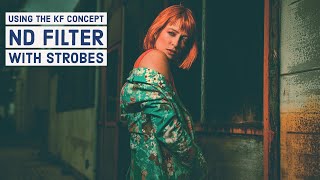Using ND filters with strobes…
Working with strobes on location is without any doubt awesome. Especially when you (like me) love the day to night look, where the model literally jumps of the screen and you can create awesome moody shots with just a little bit of tinting……love it.
Now there are some things we have to take into account when shooting outside when combining strobes with the sun.
First of all, the sun is (mostly) really, REALLY powerful compared to a strobe.
This means you need to bring some serious power, and the proper modifier.
For example a 400W strobe with a strip light and grid on 2 mtrs distance from the model won’t really do anything that you will notice on the final result. However a 1100W Hensel porty with a 14″ reflector on 3 mtrs distance on full power will probably burn the retinas from your model and give you more than a day to night shot… probably totally black background.
So choose your gear wisely I would like to add.
With this in your pocket there is something else.
Shutterspeed
When we shoot in the studio we mostly use a 1/125 shutter speed. And in essence it doesn’t really matter because the strobes will freeze the model anyway, so unless you have a lot of available light in your studio you can probably shoot also on for example 1/20 without getting blurry shots.
So lower is no problem, what about higher?
Well we can go a bit higher on some cameras/systems but most of the times it will become problematic above 1/250 even with speedlights. You probably at one time saw a black bar in your image when you shot too fast with strobes. That’s actually your second shutter curtain and is 100% normal 😀
Now don’t worry, this can be solved.
With some strobes (and most speedlights) you probably already know about the option HSS (high speed sync) instead of firing one very powerful pulse the strobe fires a lot of smaller pulses which makes it possible to light the whole sensor without any problems…. well, no problems….. the battery runs down a lot faster, the output is a lot lower and recycling is a lot longer… but it works.
There are also other solutions like HS or Hyper Sync but for this article let’s say it can be done with some “magic”. The advantage of HSS is that you can use very fast shutter speeds, sometimes all the way up to 1/8000 without losing the use of your strobe.
Because available light is controlled by the shutter speed it now means that you can shoot with a shutter speed of for example 1/2000 so you don’t have to shoot on f22 anymore to lower the available light, this also means automatically that you can now open up your aperture setting a lot creating less Depth Of Field which in my opinion can create a very nice and more surreal/moody look than the “everything is sharp” f22.
Now if your strobes don’t support HSS/HS etc. there is also another solution.
Using a ND filter
If you shoot landscapes you probably know ND filters.
Neutral Density filters are used to take away light from hitting the sensor/film. This means that you can for example shoot with insanely long shutter speeds to get that nice silky smooth water shots we all saw at least once. But you can also use this with strobes of course to cut down the available light resulting in day to night shots with a shutterspeed of 1/125 (or lower) and wide open aperture…..
Now before you stop reading and run outside to buy one….
ND filters are available in so called stops, and as you probably guessed these tell you how much light the filter takes away. So now the question of course is… “which one to buy?” well I really don’t know to be honest. Sometimes you need 3 stops, sometimes 10 stops. So wouldn’t it be cool if there was one filter that could do all..?
In todays video I show you exactly that kind of filter.
Now I’m always honest with you guys and you have to realise that using a filter like this is awesome but also comes with A LOT of problems, which can be problems or also can be hardly an annoyance depending on your camera.
I’m using a Sony A7Riv which has a awesome Auto Focus system and even when I use the filter on the max setting my AF still works, although it really becomes a bit slower, so it really depends on the camera if you can use your autofocus. But don’t worry if you can’t, you can always focus with the filter wide open and hold the shutter button, close the filter to the desired setting and press the button (or use back button focus).
Also using a light meter can be problematic because you never really know if it’s 5 stops or 5.5 or maybe 5.2 so I will use the light meter to get a ballpark reading and shoot the scene and adjust with the shutter speed, if you’re starting out I would recommend to start out by setting everything up the way you want it without any filters, now add the filter and just open up the aperture and increase the shutter speed at the same time and you should be ok.
Ok, let’s take a look at the video.
If you have any questions, feel free to ask.




